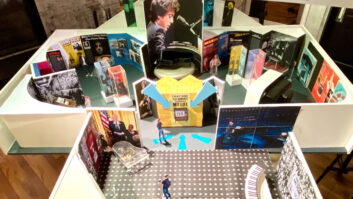How can a former rehearsal space for garage, punk and noise pop bands survive amid the escalating rents of the IPO-fueled San Francisco business climate and real estate market?
Mr. Toad’s Recording, tucked into the heart of the city’s SOMA/Multimedia Gulch district, wasn’t prepared to just roll over and croak, like so many other local studios. Owner/mastering engineer Tardon Feathered and head engineer Jeff Byrd believe the 10-year-old Toad needs to evolve with the times and become a full-service pit stop for artists and corporations alike.
“We had a big staff meeting and Tardon sat down and drew these graphs about how the business is shifting and how we’re going to move with it, and that’s the brilliance of Mr. Toad’s,” Byrd says. “Studios that have not survived-Brilliant, Russian Hill and Department of Ways and Means-have mostly disappeared due to their leases, but at the same time, from everyone I’ve talked to, San Francisco is becoming harder to sustain a recording studio. There’s not a lot of big label work here, and it tends to go to big studios.
“So in order to retain business as a mid-level studio and cater toward the local scene, we gotta offer more,” he continues. “A band could just walk in and all they need to do is bring in their instruments and some cut-up art, and we could record, master, mix and do graphics and replication work, and they could leave here with their CDs at a very affordable price. There was a great phrase that someone used for us years ago: ‘You guys are the one-stop indie rock shop.'”
Clients such as Neurosis were so impressed with the vibe of the studio that they returned to San Francisco, with producer Steve Albini, to mix their last CD. Byrd recently finished a new record by Loud Family, the current band led by Scott Miller of Game Theory. Feathered just completed mastering a new Rova Saxophone Quartet CD, which was also tracked and digitally edited at Toad. And the staff recently produced a punk version of “Joy to the World” for a Polaroid Joy Cam TV commercial.
The studio has metamorphosed from a rented rehearsal space with an 8-track reel-to-reel into a facility that offers recording, mastering, CD replication, graphic design, video production and Web media production, while retaining the decor and atmosphere of an anarchist co-op.
“We’re a project studio on steroids,” says Feathered. “We have no style-that’s our style.”
“Everybody here has been a working musician at some time or another and knows what it’s like-for someone to come in and spend that kind of money on a record or CD, you’re chopping off your arm, and you want to make sure you can put it back on,” Byrd adds. “Every time a band comes in here, I try to meet with them, we sit down and talk about the recording and what they want to get out of it because it’s an intense thing-someone’s asking you to capture their art. So one thing we’ve got here is that everybody is very professional and incredibly friendly and down-to-earth. It’s not like we just run you through and run you out.”
The studio’s main console is an automated Amek Einstein, which, according to urban legend, was used to track Whitney Houston’s vocals for The Bodyguard soundtrack, Byrd says. Tracking happens in a 36x30x16 live room with three treated areas including a floating oak soundstage with a curved back wall. On the equipment list: a 2-inch, 24-track Otari MTR-100A recorder with 24 channels of Dolby SR, vintage Calrec preamps with EQs, an Eventide 4000 effects processor, a Crane Song STC-8 Class-A compressor, a TC Electronic Finalizer, Demeter compressors and preamps and Cole 4038 ribbon mics. Digital editing is done through Digidesign’s Sound Designer II or Pro Tools 4.0.
Feathered and Byrd have also started a record label, Toadophile, because they realized they could easily and cheaply record and release good albums by their favorite local bands, such as Applesaucer, Liar and Tribal Disco Noise. In fact the first band they signed, recorded and promoted, San Francisco’s psychedelic surf band The Mermen, received such good airplay on college radio that Atlantic Records picked up the band and bought the first album from Toad.
“There were a lot of great bands in the mid- to late ’80s in San Francisco and throughout the Bay Area, but they just disappeared because no record label or A&R person gave them attention. It was frustrating, and I just saw some great talent fall by the wayside,” Byrd says.
That involved attitude came in handy when Toad recently produced a DVD/video magazine of their bands’ videos called Toadstool. Byrd dressed up in a bunny suit with a bullhorn and gave away 300 copies to lunching Web workers in the nearby South Park neighborhood-a stunt that attracted the attention of at least one local alternative weekly. “It was last-minute hare-brained scheme,” Byrd says with a laugh.
For more information, visit www.toadophile.com.






